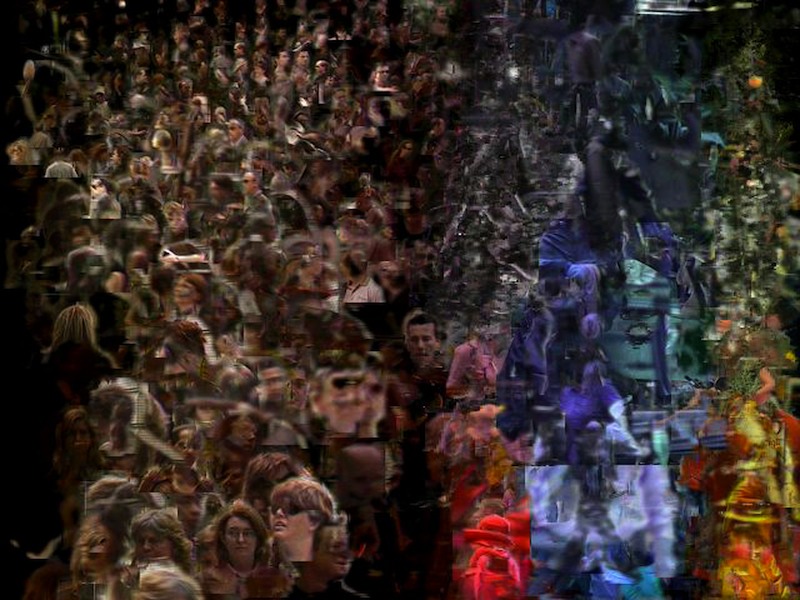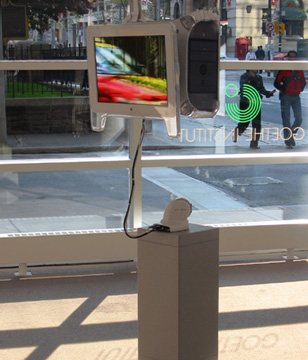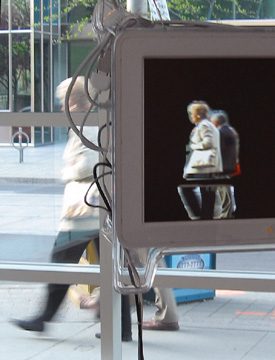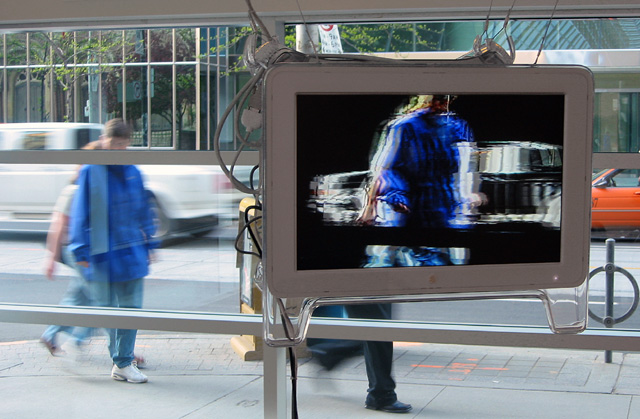
a composite image from Sorting Daemon

a composite image from Sorting Daemon
Sorting Daemon is a site specific installation commissioned by and designed for the Goethe Institut Toronto gallery space for their "Surveillance Terrorism Democracy" program in the spring of 2003. The piece was triggered by my concerns about the increasing use of automated systems for profiling people as part of the "war on terrorism" and is an attempt to help ask questions about appropriate uses of technology.
Like many of my other works, "Sorting Daemon" surveys its environment and uses the resulting images as the primary content of the work. In this specific case, the system looks out onto the street, panning, tilting and zooming, looking for moving things that might be people. When it finds what it thinks might be a person, it removes the person's image from the background.
The extracted person is then divided up according to areas of similar colour. The resulting swatches of colour are then placed within the arbitrary context of the composite image projected in the KinoWelt Hall at the Institut.
On the left side of the composite, flesh-coloured patches are sorted by hue (olive on the left, pink on the right) and size (largest on the bottom and smallest on the top.
The right side accumulates all the other coloured patches, sorted by hue horizontally and saturation vertically (with most saturated at the bottom. (Saturation is the intensity of the colour.)
The extracted person first appears 'whole' at the bottom of the composite and then slowly separates into coloured regions which each move to their appropriate location in the composite.

Computer, LCD screen and camera |

A couple passing by and their image extracted |
As an artist, I create systems rather than pictures, and it is an inherent part of my process that I will not know what the result of the process will look like. I have defined the processes, but that is very different from defining the actual resulting output. The painterly look of the composite is an accidental byproduct of the ordering process. The composite seems chaotic but is actually a completely rational and ordered process.
One of my deepest interests is to try to understand how computers and humans are different. On the surface, it seems relatively easy to differentiate between the two, but as computers become more powerful, many of the capabilities that were clearly displayed only by human beings, are now apparently shared by computers. There are many who are now claiming that computers will soon be able to match human intelligence. I find this a startling claim that need intense examination. Many of my works have been, in part, an investigation of this question and a critic of the assumptions that are being made in this regard.
A second stream of my work over the past 10 years has examined vision, and by extension 'surveillance'. I have created many systems that 'see' in various ways. These endeavours have left me greatly impressed with our own human vision. It is extraordinarily hard to create computer systems that can do the simplest things that we do with our eyes and brain and take wholly for granted. I am astonished at how willingly and easily we underestimate the complexity and subtlety of our own human faculties. If we underestimate ourselves, then we will be in danger of putting machines to work in situations where these undervalued human faculties are actually essential elements.
This sort of problem becomes very clear in contexts where computers are asked to begin making 'judgments' on people. Computers have no grasp of the social and moral realms. A computer program is a manifestation of the will of the programmer, but it is a will divorced from social, emotional, moral and philosophical constraint.
Surveillance systems are becoming increasingly automated. It is no longer necessary to have a security guard keeping track of a multitude of surveillance monitors. Cameras are increasingly outfitted with built-in computers to enable them to make decisions about when something suspicious or worthy of note is taking place. To implement these, programmers are writing programs that attempt to automatically classify people by appearance and behaviour. To do this, they must uncover visual and behavioural traits (effectively 'stereotypes'), and in doing so, 'discrimination' becomes formalized. Its seems that we are more comfortable letting our machines be prejudicial for us. (and it certainly is more convenient)
"Sorting Daemon" is an exploration of these issues. As I watch, experience and consider its processes in action, I hope to learn more about the issues that I hope it raises, as well as finding increasingly effective ways to express them to the general public. (Contents)

The LCD panel displaying the captured motion of the person in blue.
2003
New Forms Festival,
the Roundhouse, Vancouver, Canada
Images Festival,
Goethe Institut, Toronto, Canada
2005
Achieving Human Security, Canadian Embassy, Berlin, Germany
2010
Sorting Daemons, Agnes Etherington Art Centre, Queen'€™s University, Kingston, Canada
Copyright 2010 David Rokeby / very nervous systems / All rights reserved. 11/25/10